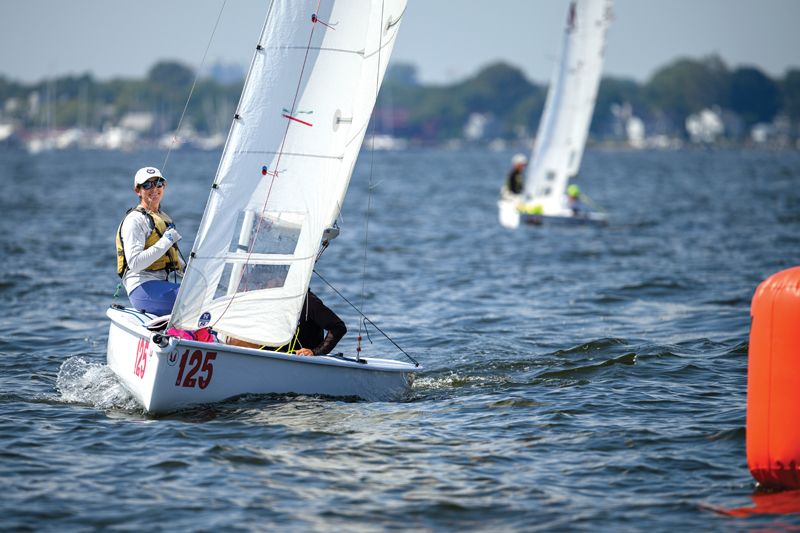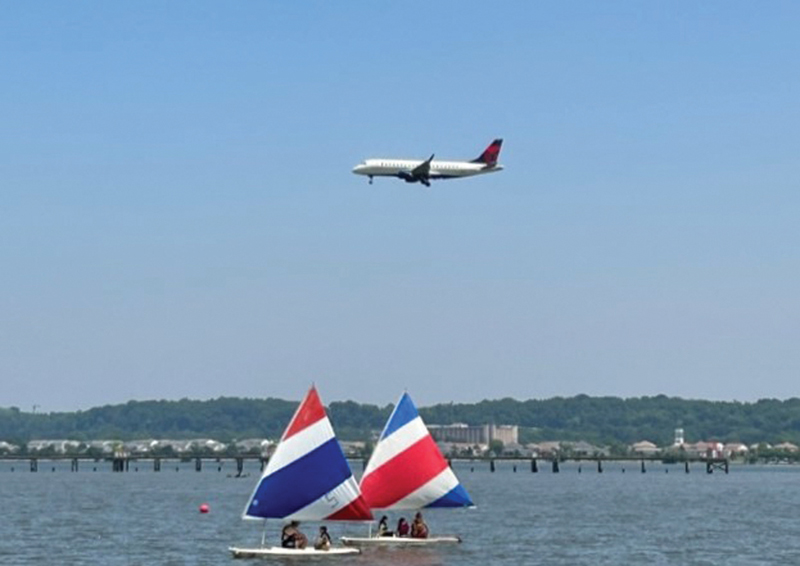The Shape of Wind Shifts
Shift happens! As small-boat racing sailors, we know that the wind is what powers our motion—and that changes in the wind affect our speed and direction, as well as how to set up and handle our boats. Tracking the weather forecast for your day of practice or several days of a regatta gives you a good idea of roughly how much wind to expect, where it will be coming from, and how that direction may trend.

But when you get out there on the racecourse—while certainly you keep that big-picture forecast context in mind—you need to rely more closely on what you actually experience. Using what you see, hear, and feel can help you succeed on the racecourse.
The whoooooosh of wind over water lets us know there’s a puff, and if you hear it more loudly in one ear than the other, it can indicate where the breeze is coming from. Oftentimes a spinnaker trimmer, focused solely on watching the shoulder of the kite for that perfect curl, first senses an increase in breeze on the back or side of their neck, letting them anticipate how that puff will affect the chute. But the most frequent way we talk about puffs and shifts is by communicating about how we see them.
We see areas of increased windspeed by noticing the darker areas on the water, as well as the presence of whitecaps. We can see the effects of wind by noticing how wind affects flags on shore or smoke coming out of smokestacks; how other boats around us are sailing, and if they are heeling more or less (or sometimes capsized!). Other local occurrences tip us off, too. If you sail near an airport, you’ve likely noticed that air traffic patterns change with the wind: Planes generally take off and land into the wind. If they have been taking off in one direction all morning, and they change directions—expect a change in your wind direction, too.
Now wouldn’t everything be nice and easy if the only thing that changed when a puff or lull hit was that the windspeed changed? Instead, when you encounter a puff (or leave its effect), the wind direction changes too. Wind shifts do keep our game interesting! Anticipating how a puff may bring a shift can help you gain the most out of it.

Two kinds of wind puffs you can see
At the risk of oversimplification, I’d say there are generally two different kinds of puffs that you can see. Both happen in the overall context of that weather forecast—perhaps that the wind will generally be backing or veering over a given time period, or that you’re expecting a fairly consistent direction all day.
One type of puff is a “cat’s paw” puff. I call these cat’s paws not only for their shape—they present on the water as a fan—but because they can surprise you, come at you quickly, and can be a little shocking, much like a crazy cat whacking its paw at you (I’m more of a dog person). Cat’s paw puffs are often the result of air mixing down onto the water. That “down” action (rather than “across” the top of the water) is why the puff, when it hits the water, needs to spread out. And that means the wind in this puff moves in different directions. As it moves out in a fan shape, boats to the right of the center will get a leftie, while boats to the left of the center will get a rightie.
Cat’s paw puffs are not as consistent as other puffs—they’re not a puff that you can see and say, “Hey let’s sail 200 more yards to get into this reliable breeze.” But knowing how they work and anticipating a header or lift depending on how you are sailing into the puff can be a big benefit.
The other basic type of puff can be seen as a line—essentially that the leading edge of the increased breeze is a straight line. In these, the wind generally shifts toward the way the puff is coming from. Maybe there’s a relatively straight line of breeze, or a broad arc, coming down the course from the top right of the racing area. In this case, I’d expect the puff to bring a right shift. That right shift is fairly consistent no matter where you enter the puff, unlike the “where you enter it matters” element of a cat’s paw puff.
These line puffs often occur thanks to geography around the racecourse: Are you racing on a river surrounded by high cliffs, so wind funnels down the river? Does a peninsula or island stick out above your racecourse altering wind flow? They can also happen when “cat’s paw” puffs persist for a bit and their leading edge spreads out and broadens across the water.
So which way will the wind shift in that next puff? Keep your eyes on the shape. Communicate with your skipper and the rest of your team. Nobody can presage the direction of a puff 100 percent of the time, but giving the team a heads-up that something will be changing is well over half the battle!
by Kim Couranz
About the Author: SpinSheet Small Boat columnist for more than a dozen years, Kim Couranz has earned several national and world titles in Laser Radials (ILCA 6) and Snipes. She has also raced J/22s, J/24s, and Ynglings on an international level.




